Photo Essay: A Look at How Climate Change Affects Poor Urban Communities in Surat and Semarang
This blog post originally appeared in TheCityFix.
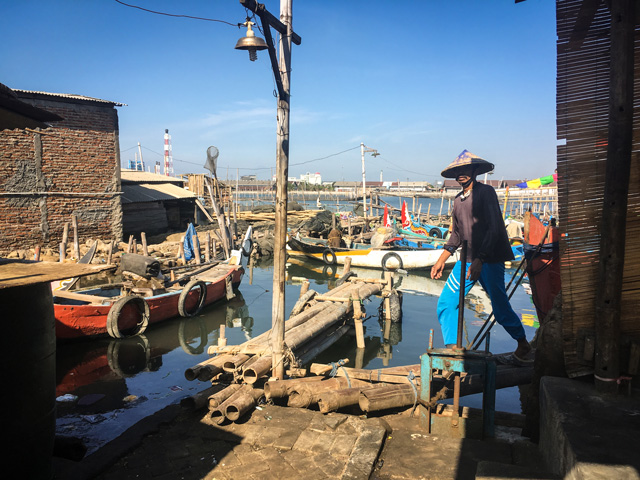 Photo Credit: Lubaina Rangwala/WRI India
Photo Credit: Lubaina Rangwala/WRI India
One of the biggest challenges to climate action is not only understanding the risks of flooding, extreme heat and other challenges, but how your community might respond to these risks. What are its strengths? How might policymakers augment existing capacities and address weaknesses?
WRI’s Urban Community Resilience Assessment helps communities answer these questions. By analyzing local capabilities like social cohesion, familiarity with climate risks, early warning systems and disaster readiness, the assessment provides a snapshot of preparedness and people’s perception of risk. The assessment enables individuals to identify context-specific adaptation actions and encourage policymakers to engage communities in resilience planning.
This year, we applied the Urban Community Resilience Assessment to two Asian cities: Surat, India, and Semarang, Indonesia. As part of the process, we selected three communities in each city and conducted field visits to get a sense of the kinds of challenges they face and the ways in which community members are adapting. The full report of our findings will be released in the fall, but the sheer variety of challenges faced by different communities in each of the cities is illustrative.
Even though Surat and Semarang are both coastal cities with small rivers, the vulnerability contexts of each city, and each of the three communities, are significantly different. While Surat faces two major risks – extreme heat on one hand, and flooding during heavy monsoon days on the other – Semarang is exposed to various risks based on geography. Coastal settlements are highly vulnerable to sea-level rise, storm surges and land subsidence (sinking), whereas settlements along the inland river are at risk of flooding during heavy rain, and communities living in the hills face landslides.
Differential Risks in Surat
To capture differential risks in Surat, we selected different housing types based on people’s built environment, occupation and social capital. The first community assessed is an old slum called Morarji Vasahat, located in the southern part of the city, which has a large industrial zone.
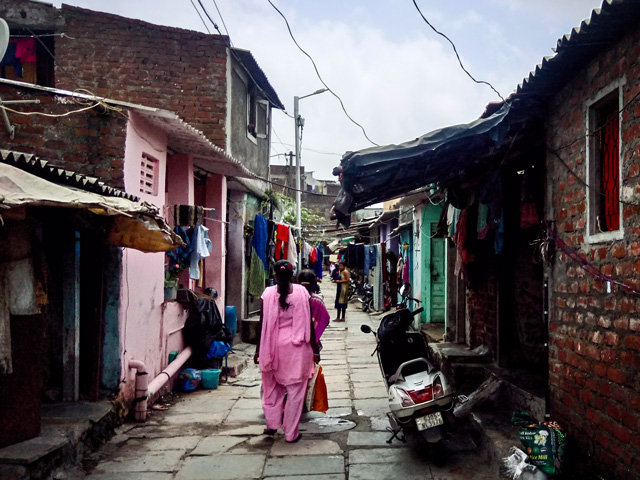 Photo Credit: Lubaina Rangwala/WRI India
Photo Credit: Lubaina Rangwala/WRI India
Morarji Vasahat is in a low-lying area and is frequently at risk of waterlogging, overflowing drains and extreme floods, especially during the monsoon months. However, since it is an old slum, most households have lived together for decades resulting in strong social networks and friendships that serve as a source of strength during extreme events. Moreover, the community temple runs a trust that leads disaster management efforts by evacuating people to shelters located on higher ground and organizing emergency food and services distribution.
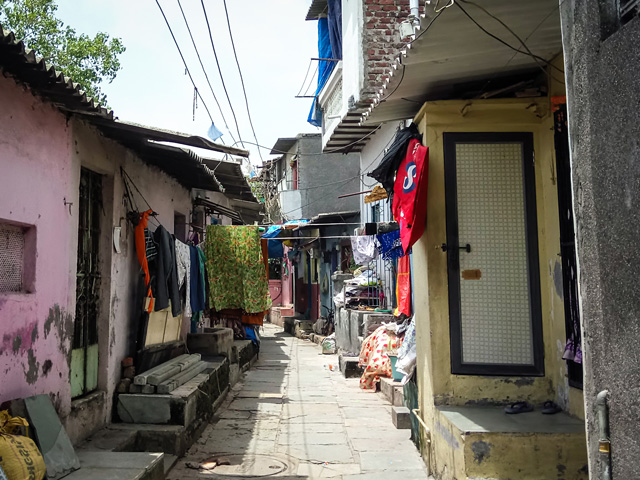 Photo Credit: Lubaina Rangwala/WRI India
Photo Credit: Lubaina Rangwala/WRI India
In preparation for the monsoon season, households come together to clean-up their drains, repair and waterproof their roofs, and ensure that the roads leading to their homes are maintained. Most households have constructed high plinths for their homes, raising their floors one to two feet off the ground. These small changes are made to prevent rain and sewage water from entering their homes. In the summer, residents use the plinths, commonly known as otlas, as outdoor seating spaces to escape stifling internal temperatures aggravated by metal roofs.
 Photo Credit: Lubaina Rangwala/WRI India
Photo Credit: Lubaina Rangwala/WRI India
The second community assessed in Surat was a slum rehabilitation scheme called Kosad Awas. In 2009, 19,000 households from different parts of the city were allotted homes in this area under a massive relocation and rehabilitation project. People from different slum communities were given rooms in disparate buildings without taking into account their existing social ties. This has led to severe issues of social incoherence, increasing theft and small crimes, and making it unsafe for women and children.
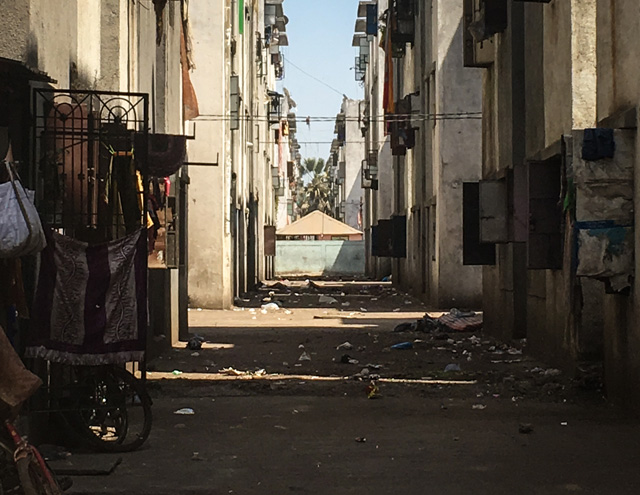 Photo Credit: Lubaina Rangwala/WRI India
Photo Credit: Lubaina Rangwala/WRI India
These alleyways between the backsides of buildings, where the toilets are positioned, have turned into crime hotspots. Even though the residents of Kosad Awas are not exposed to flood risk on a regular basis like in Morarji Vasahat, lack of ventilation and overcrowding in their small homes makes them vulnerable to heat during summer days. Due to an overwhelming fear of theft most residents at home during the day – mostly women and children – keep their windows closed, resulting in increased indoor temperatures. Furthermore, a general lack of trust in the community makes it difficult to respond to emergencies as residents fear each other.
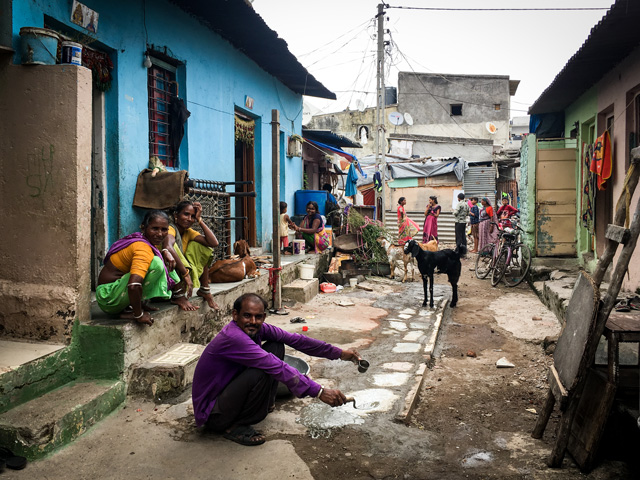 Photo Credit: Lubaina Rangwala/WRI India
Photo Credit: Lubaina Rangwala/WRI India
The third community in Surat is a site and services scheme in Ugat, located in the west of the city. Thirteen years ago, slum residents were relocated here and given legal rights to plots of land, where many built their own homes incrementally over time. After two years, they were given a water connection outside their homes, connected to the city’s electricity grid and, to greater and lesser degrees, hooked into the sanitation system.
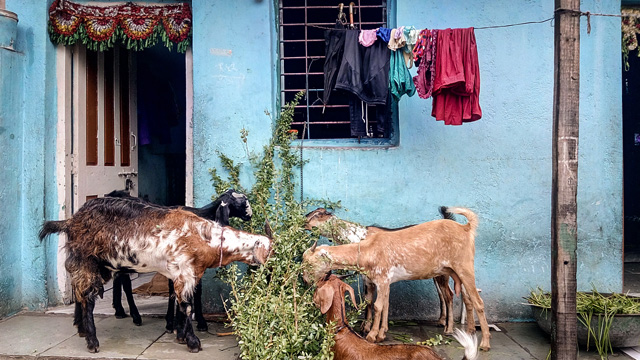 Photo Credit: Lubaina Rangwala/WRI India
Photo Credit: Lubaina Rangwala/WRI India
Several households engage in animal husbandry and rear goats, chicken and pigs. These activities, alongside already underbuilt road infrastructure, open drains, and mismanaged garbage disposal systems, have led to extremely poor health and sanitation in the slum. During the monsoons, Ugat faces frequent flooding and water logging in most parts, followed by increased health risks due to unhygienic conditions. Here, santiation is the clear challenge.
Living With Risk in Semarang
The first community assessed in Semarang was Tanjung Mas, a fishing community in the north of the city, along the coast.
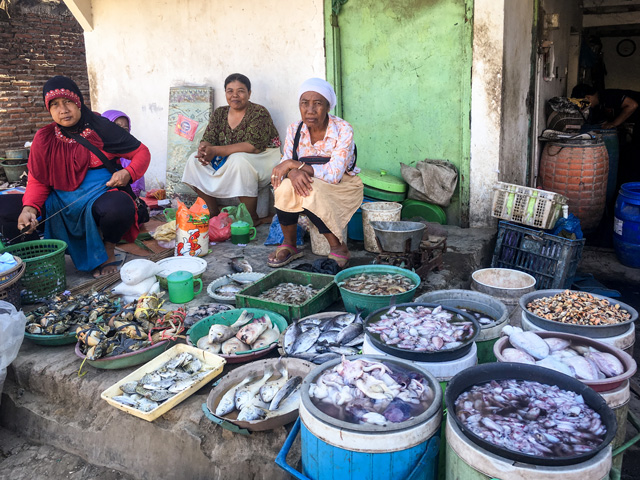 Photo Credit: Lubaina Rangwala/WRI India
Photo Credit: Lubaina Rangwala/WRI India
People sorting, drying, and selling fish, net menders, boat repairmen, and other evidence of the fishing industry can be spotted along the edges and crossroads of the settlement.
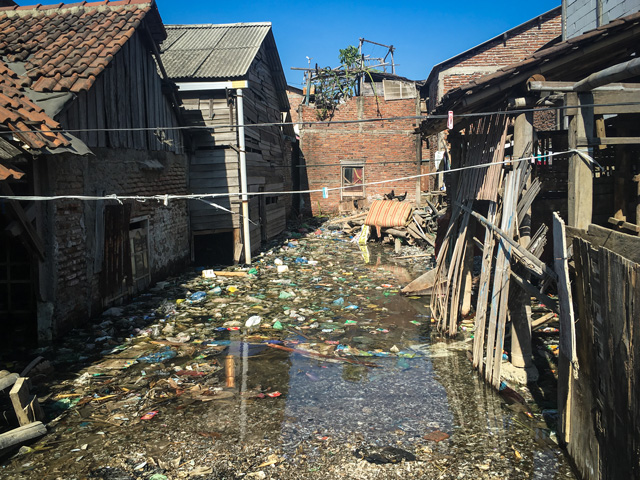 Photo Credit: Lubaina Rangwala/WRI India
Photo Credit: Lubaina Rangwala/WRI India
The climate risks here are more immediately obvious than Surat. The ocean literally intrudes on people’s lives each day. During high tide, many homes, streets and alleys are flooded with seawater, which later recedes following the returning tide.
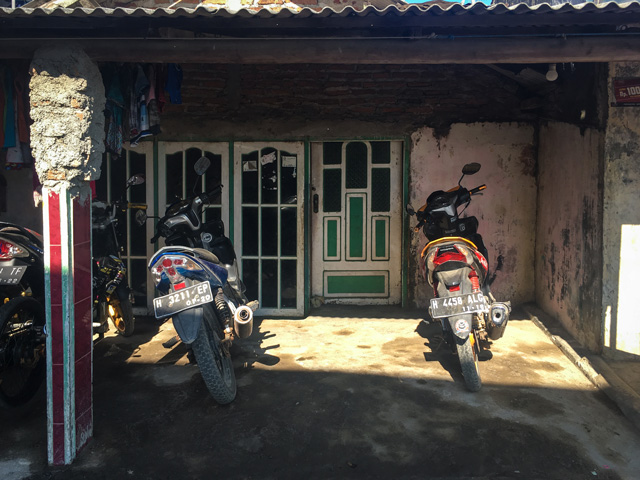 Photo Credit: Lubaina Rangwala/WRI India
Photo Credit: Lubaina Rangwala/WRI India
Due to the constant daily flooding, the soil has softened, leading to frequent instances of land subsidence. We saw several homes that had partly sunk into the ground, some only three or four feet high; others had fully subsided, leaving only eves above ground. Based on their economic capacities and risk of exposure, residents have adapted differently. Some have raised their roofs, adding additional height to save their homes (for now).
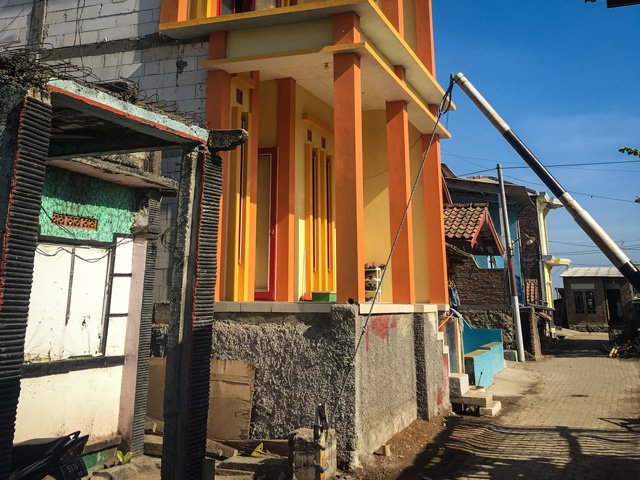 Photo Credit: Lubaina Rangwala/WRI India
Photo Credit: Lubaina Rangwala/WRI India
Others have built new two-storied homes on six-foot high plinths to prevent seawater from entering and minimize the risk of subsidence.
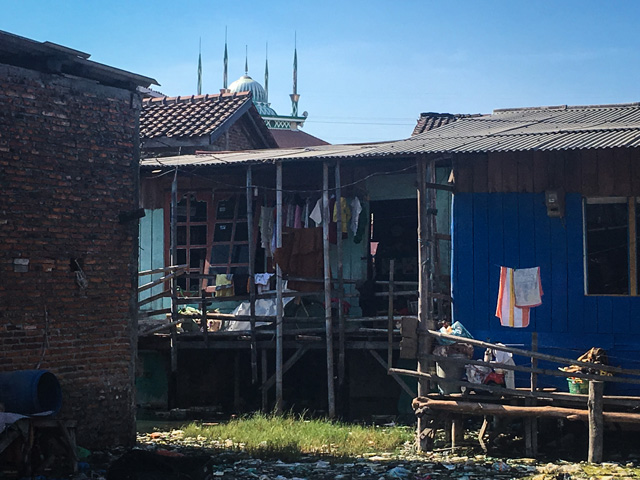 Photo Credit: Lubaina Rangwala/WRI India
Photo Credit: Lubaina Rangwala/WRI India
In some cases, residents have propped up their ho 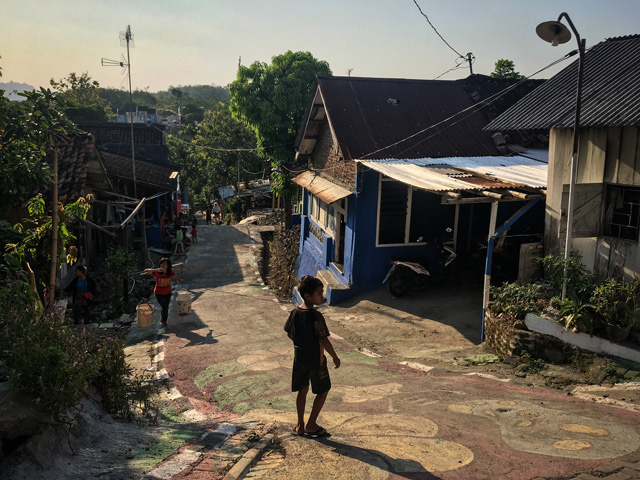 mes on stilts and built bridges that connect their homes with neighbors.
mes on stilts and built bridges that connect their homes with neighbors.
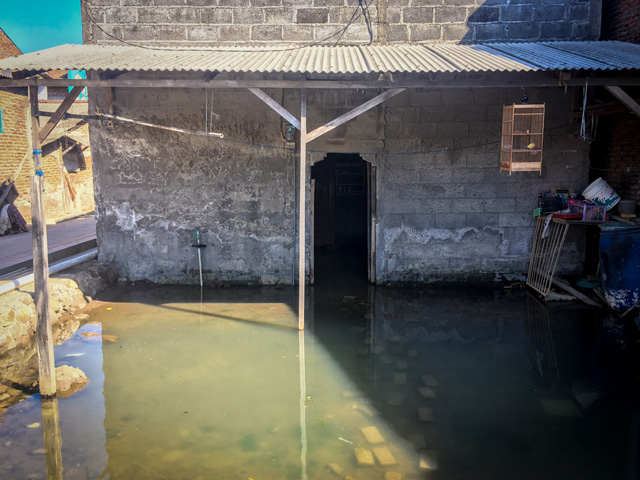 Photo Credit: Lubaina Rangwala/WRI India
Photo Credit: Lubaina Rangwala/WRI India
Many have simply learned to live with the sea. This home had sunk a foot below ground level, resulting in the front porch and interior spaces being perpetually flooded. Residents had laid out bricks along the walkway to the house and inside the home to mark commonly used paths.
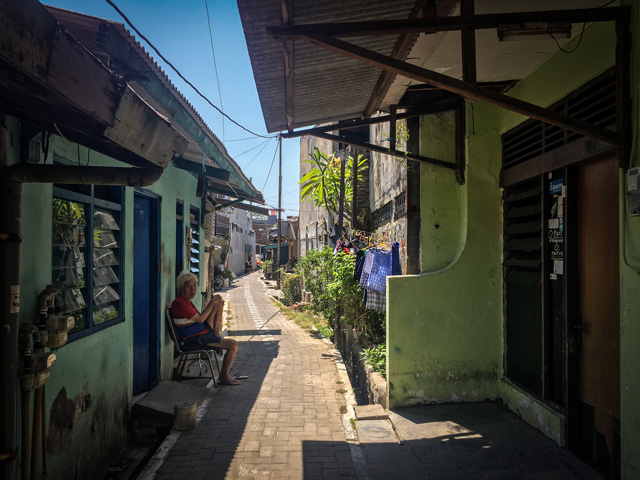 Photo Credit: Lubaina Rangwala/WRI India
Photo Credit: Lubaina Rangwala/WRI India
The second community we visited in Semarang was Kaligawe, located along the city’s canal, slightly inland from the coast. The low-lying area experiences frequent flooding when the sea flows up into the canal during heavy monsoon rains. In some places, communities have elevated the roads to improve access and mobility. However, in the poorest areas, households are often unable to raise their floor heights with respect to the new road level, leading to internal flooding.
 Photo Credit: Lubaina Rangwala/WRI India
Photo Credit: Lubaina Rangwala/WRI India
The third community we selected is Sukorejo, located in the southern hills. This is an old indigenous community, where most people continue to live in their ancestral homes. The soil in this part of the city is very porous and tends to continuously shift, resulting in frequent and sometimes intense landslides. Additionally, the community struggles with severe water scarcity and frequent drought-like conditions during the summer months.
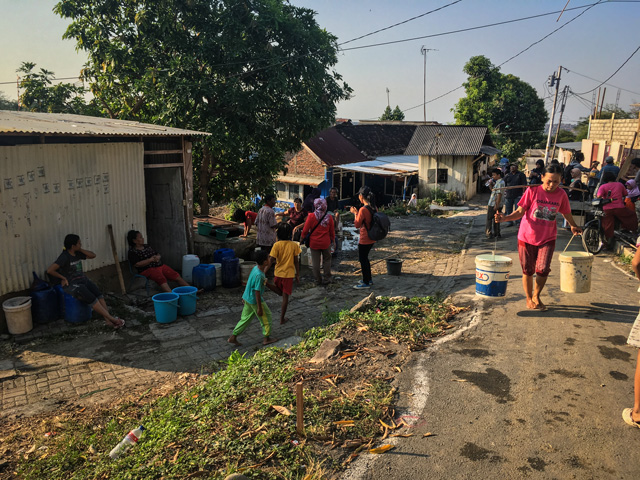 Photo Credit: Lubaina Rangwala/WRI India
Photo Credit: Lubaina Rangwala/WRI India
Landslides remain a challenge, but the community has adapted quite incredibly to problems of water scarcity. People are largely dependent on one community water source: a natural spring that fills a well. The settlement is divided into seven sectors, each of which is allocated one day of the week for collecting and storing as much water as is required.
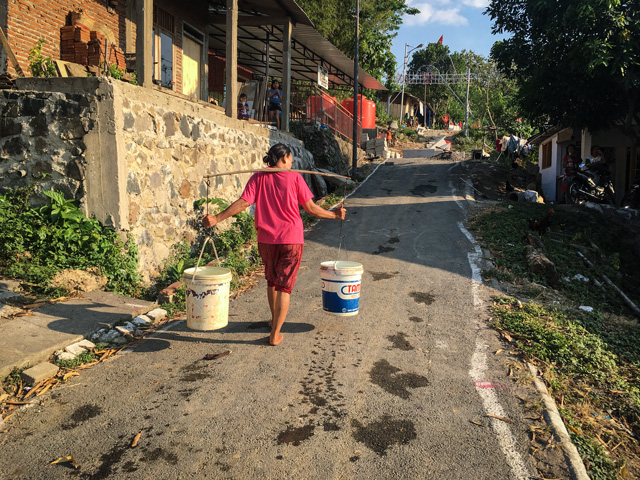 Photo Credit: Lubaina Rangwala/WRI India
Photo Credit: Lubaina Rangwala/WRI India
Residents trek to the well and refill their outdoor tanks, drums and buckets in batches. The water is meant to last the family for an entire week. In the event that a household runs out, they are allowed just two additional buckets per day for the rest of the six days. The system ensures that water is used in a sustainable and intelligent manner.
—
The field experiences from Surat and Semarang have strengthened our premise that peoples’ everyday well-being, the spaces they live in, the work they do, their potential to cope with increasing and varied challenges, and their aspirations for secure and equitable living environments are important to the success of any resilience strategy. Resilience is a continuous process, and communities and individuals are already adapting every day. The important question for planners is whether resilience actions at the wider city, state or national level are enhancing local knowledge and capacities – or constraining them.
The Urban Community Resilience Assessment is a year-long project led by staff from WRI’s Urban Climate Resilience team and funded by the Cities Alliance Joint Work Program on Resilient Cities; a full report will be released in September 2018. Local partners in both cities – the Urban Health and Climate Resilience Center for Excellence in Surat, and the Initiative for Urban Climate Change and Environment in Semarang – are integral collaborators and have led field activities in each settlement. The assessments will lead to proposals of resilience projects in each community that will be co-developed with community members and stakeholders from the city.